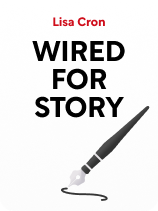

This article is an excerpt from the Shortform book guide to "Wired for Story" by Lisa Cron. Shortform has the world's best summaries and analyses of books you should be reading.
Like this article? Sign up for a free trial here.
What does foreshadowing accomplish in a story? How can it be used to powerful effect with your readers?
In Wired for Story, Lisa Cron explains that humans have an innate need to understand the reasons behind everything—to make sense of what’s happening to us and around us. One of the techniques that writers can use to satisfy this human need is foreshadowing.
Keep reading for Cron’s exploration of foreshadowing in a story and how it affects readers.
Foreshadowing in a Story
Cron argues that our brains evolved to absorb information through stories. So, writers who want to create compelling narratives should write in a way that satisfies our brains’ expectations of story. Stories developed hundreds of thousands of years ago as a way to keep us safe from potential dangers without us actually experiencing them, and thus we’ve evolved to crave them. Today we continue to use stories to experience simulated realities in order to understand life.
Part of the way we make sense of what’s happening to us is to call on memories from the past that help us interpret what’s going on in the present. According to Cron, you need to provide your reader with such memories so major reveals in the story will make sense.
To do this, you can use foreshadowing in a story. This is when you give the reader hints about a change that’s going to happen later in the story. When you foreshadow, you essentially create a memory for the reader to recall later, and that memory helps them make sense of eventual character or plot changes. Foreshadowing importantly also lets you justify a choice by your protagonist that seems out of character. In fact, any out-of-character choice your protagonist makes must be warned of in advance.
| It’s Easier to Call on Emotional Memories The brain pays particular attention to memories that evoke emotional responses in order to make sense of what’s happening. Because of this, you can even manipulate how well the reader is likely to remember a memory you implant for them by adjusting the emotional impact it has. For example, if you want the reader to be able to call upon the memory easily as the story goes along, you can present it in a highly emotional context that will make it stick in the reader’s memory, such as by showing its immediate emotional effects on the protagonist or other characters. Conversely, if you want the memory to be somewhat buried so the reader only remembers it when it suddenly becomes relevant, you can couch it in scenes or contexts where the emotional impact is unclear or is only described later. |
For example, if you establish in chapter one that your protagonist has a deathly fear of flying but, later, they need to get on a plane to save the world, you have to include information in those intervening chapters that justifies this choice, such as describing how the protagonist is taking steps to overcome their phobia.
(Shortform note: You can choose to foreshadow things in your story in a number of ways. The type of hint-dropping that Cron describes is called indirect foreshadowing, but you can also give information that makes a clear prediction about what will happen later, which is called direct foreshadowing. This gives the reader an explicit memory that they can expect to see play out in the story later. You also don’t have to limit your foreshadowing to the text of your story: You can plant hints about the plot in your story’s title or setting. To foreshadow well, avoid inundating your reader with hints, and make sure they’re spread out rather than concentrated in one spot.)

———End of Preview———
Like what you just read? Read the rest of the world's best book summary and analysis of Lisa Cron's "Wired for Story" at Shortform.
Here's what you'll find in our full Wired for Story summary:
- How humans have a neurological need for stories
- The formula that the human brain expects to encounter in a story
- How to build a protagonist that engages your reader






